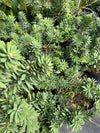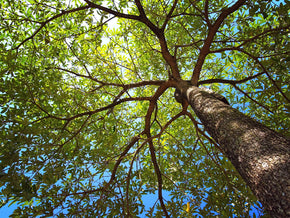Planting fruit trees at home can provide many benefits to you, your family, and your environment. There’s a common misconception that fruit trees are high maintenance, but most fruit trees are actually fairly easy to care for. While newly planted trees can take a few years to start producing fruit, you’ll soon be able to enjoy fruit that’s been grown in your own backyard.
One benefit of planting fruit trees at home is that doing so can save you money. Once your fruit trees begin to produce fruit, you won’t have to go to the grocery store to buy fruit. You can save the fruit from your trees for later by canning it or putting it in the freezer, so you don’t have to worry about waste. Then, you’ll be able to enjoy your homegrown fruit even after your trees are done blooming for the season.
Fruit trees also provide food for the long-term. Certain fruit trees can live to be over 100 years old, and since fruits are perennial, you won’t need to replant them.
Growing your own fruit trees is a simple way to add some joy and pleasure to your life. But which fruit trees are best suited for planting in Louisiana? This article will cover the best fruit trees to plant in Louisiana, so you can start picking fruit off your trees even sooner.
Fig
One of the best fruit trees you can plant in the Louisiana climate is a fig tree. This is because figs are one of the best adapted fruits to the Gulf States region.
Fig trees are low maintenance and don’t require a ton of work or upkeep to stay healthy. They do better in a location that’s well-drained, but they can easily survive in a wide variety of soil conditions.
Citrus (orange, lime, lemon)
If you’re looking for a low-maintenance fruit tree to plant in your backyard, citrus is the way to go. Generally, citrus trees require minimal pruning. They are usually fairly vulnerable to cold temperatures, so it can take a while for a citrus tree to recover if it’s been injured by freezing weather.
Blueberry
Blueberries grow on bush-like trees, and they’re also incredibly low-maintenance. They need acidic soil and mulch to nurture their shallow, fibrous roots. Typically, blueberry plants will start producing a full crop of fruit three years after planting.
It’s best to plant blueberries in an area that gets full sun. If you want to guarantee cross pollination and healthy production of fruit, consider planting multiple varieties. Different types of blueberries include Brightwell, Climax, Tifblue, and Premier.
Pomegranate
Pomegranates are delicious fruits that are commonly found in older parts of Louisiana. They grow in the form of a large, 15-foot shrub, and they benefit from sandy soil with even moisture. As for climate, pomegranate plants enjoy cooler winters and hot, dry summers.

Similarly to blueberry plants, you should plant pomegranates in an area where they will receive full sun rather than shade. If you plant pomegranates in shade, you may risk decreasing the plant’s fruit production by as much as 50 percent.
Persimmon
You’ll find persimmons growing in Louisiana that belong to both native and oriental varieties. However, oriental persimmons are preferred for growing in the Louisiana climate. The oriental fruits are usually 7-10 times larger than the native ones, and they typically have substantially fewer seeds. This makes for a much more pleasurable eating experience!
When planting persimmons, be sure to choose a location that allows for partial sun or partial shade. The most popular varieties of oriental persimmons are called Fuyu and Hana Fuyu.
Loquat
Another great fruit tree that is suitable for the Louisiana climate is the loquat tree. Loquats fall into the low maintenance category as well, making them an ideal option if you’re new to growing fruit trees.
Loquat trees grow to be about 25 feet tall, and their canopy can spread 15 to 20 feet wide. A larger fruit tree like this one makes an attractive addition to your home landscape. This type of fruit tree tends to be sensitive to cold weather. They can tolerate temperatures as low as 10 degrees Fahrenheit, but beyond this point, their flowers and fruit will die.
When you set out to plant a loquat tree, be sure to choose a sunny location that’s at least 25 to 30 feet away from any buildings, structures, other trees, or electrical lines. Caring for your loquat tree is easy; fertilize it three times per year with lawn fertilizer, water the tree throughout the spring, and promptly pull any weeds that crop up around it.
Pecan
The pecan tree is a large tree that produces tasty, savory nuts that are the shining ingredient in many recipes. Pecan trees can be slightly higher maintenance than other fruit trees because they do tend to drop a large amount of leaves, twigs, and fruit during the fall. They can grow as large as 130 feet tall and 75 feet wide, so you need to have a lot of space to plant this tree.
The best type of pecan variety to plant in Louisiana is called Elliott. Be sure to plant the tree at least 30 feet away from any structures in a spot that gets plenty of sun. Pecan trees need at least three feet of good, well-drained soil at a pH level between 6 and 7.
Pecan trees require cross pollination to reproduce, so you may need to plant more than one to harvest the amount of nuts you desire. Or, if there are other pecan trees in your neighborhood, you may be able to rely on them for your tree’s pollinating needs.
Also, keep in mind that pecan trees need a lot of water. When they’re young, they need 10 to 15 gallons of water per week from either irrigation or rain.
Plum (Methley, Santa Rosa, Morris)
Plums have an excellent taste on their own and also make a great jam or jelly. These trees need full sun and sandy, well-drained soil to flourish. Ideal soil for a plum tree has a pH between 5.5 and 6.5. You can easily test your soil before planting to make sure conditions are appropriate.
The best plum varieties to plant in Louisiana are Methley, Santa Rosa, and Morris. You may consider planting one of each variety in your yard. All of these varieties need an average amount of water during their growing season and more water when the climate is very dry.
Methley plums turn a vibrant purple color as they ripen, and their flesh is deep red. These plums typically ripen during the second half of July and are a tasty summer treat. They are also self-pollinating and serve as a good pollinator plant for other Japanese varieties of plums.
The Santa Rosa plum is large and red with golden-colored flesh. This type of plum ripens during the first half of August, and its flavor is deliciously sweet.

Finally, the Morris plum tree produces fruit that is purple on the outside and red on the inside. These plums are sweet and juicy and can be eaten fresh or used in cooking.
Mayhaw
The mayhaw tree was adopted as the official state fruit tree of Louisiana in 2014.
A fruit that is closely related to apples and pears, mayhaw fruit trees are medium in size and are native to the swampy lowland areas of Louisiana. Mayhaw fruits are similar in appearance to crabapples, and while they tend to be too tart for most people to eat raw, they are popular star ingredients in jams, syrup, and wine.
The mayhaw tree blooms in early spring and requires moist, well-drained soil that has a pH between 6 and 6.5. Be sure to plant mayhaw trees about 20 to 30 feet apart to allow them sufficient room to grow.
Mayhaw trees fall into the higher maintenance category than some other fruit trees because they are fairly susceptible to diseases. After planting, be on the lookout for a common disease called quince rust which causes pimple-like bumps to cover the fruit and stems. You can prevent this disease by spraying the trees with a fungicide as they bloom.
Satsuma
Similar to its citrus relatives, satsuma trees require temperate climates and plenty of sun. These trees tend to fare slightly better in cold weather than other citrus varieties.
The satsuma fruit is a type of mandarin with delicious, sweet flavor, few seeds, and loose skin. They are a popular growing choice in Louisiana. You may consider planting the Owari variety or the newer LSU Early variety of satsuma.
The best time to plant satsuma trees is during spring after cold weather has passed. Make sure its soil is well-drained, and provide it with consistent water and citrus fertilizer year-round. The best place to plant a satsuma tree is on a sunny wall, so it can absorb as much heat and sun as possible during the winter months.
Kumquat
Finally, kumquat trees are small, attractive, and easy to care for. The fruits have a slightly sour taste and a sweet, edible skin. Kumquat trees can grow to be 15 feet tall and 12 feet wide, and some varieties produce fruit two times per year. The ideal time to plant a kumquat tree is during late winter or early spring, after the cold weather has melted away.
These trees are self-pollinating, so you don’t need to plant more than one. Plant kumquats in full sun and slightly acidic soil that is well drained. When watering, aim to keep the soil moist but not soaking wet.










